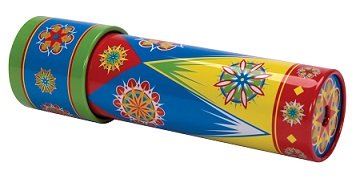Kaleidoscope

A kaleidoscope contains several mirrors placed at an angle to each other, usually 60 degrees. This allows multiple reflections to be created of the objects inside the kaleidoscope. Typically there are three rectangular mirrors making an angle of 60 degrees to each other. These three mirrors form an equilateral triangle.
Check out a video of the view you have through a kaleidoscope:
The kaleidoscope is first pointed towards a light source. This illuminates the objects inside. Next, the tube of the kaleidoscope is turned. This causes the objects to tumble. The reflections of these tumbling objects creates reflected images of varying colors and patterns. Because of the nature of the reflections, a beautiful symmetrical pattern is created in the images.
A container inside the kaleidoscope is what holds the objects. The objects used are chosen to be colorful, which adds to the beauty. The objects can be beads, glass pieces, or whatever else. As the kaleidoscope is turned, the objects tumble, but only the ones that move within close proximity to the mirrors get reflected. Due to the randomness of the tumbling action, you never see the same set of images twice. As a result, the kaleidoscope produces a constantly changing set of unique, yet breathtaking, images.
Having multiple mirrors in the kaleidoscope results in reflections of reflections. And this, combined with the orientation of the mirrors relative to each other, is what creates the images we see.
A kaleidoscope is one of the oldest science toys. It's been around for two hundred years, and is still very popular today.
Return to Science Toys page
Return to Real World Physics Problems home page
Free Newsletter
Subscribe to my free newsletter below. In it I explore physics ideas that seem like science fiction but could become reality in the distant future. I develop these ideas with the help of AI. I will send it out a few times a month.